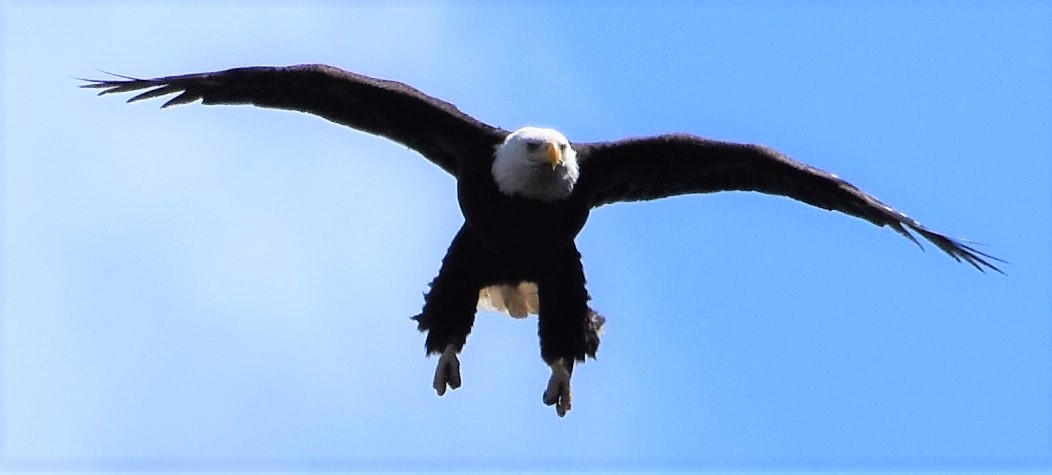
"Do not go where the path may lead, go instead where there is no path and leave a trail."
Ralph Waldo Emerson






Bald Eagle pastel by Wendy Hall
Sylvia by Brenda Dadds Woodward



|
Bald Eagles in
the Adirondacks
Haliaeetus leucocephalus Order: Accipitriformes Family: Accipitridae Genus: Haliaeetus The bald eagle is
not only our nation's most recognizable natural symbol, and the only eagle
found exclusively in North America, it is also the endangered species act's
most prominent success story, and a reminder of how important are the protection
of our wildlife, critical habitat and natural resources generally. The number one killer of the bald
eagle in America today is lead poisoning, which the eagles pick
up while scavenging the remains of game, mainly white tailed deer taken
by hunters using lead based bullets, which shatter on impact, sending lead
shards into flesh, often away from the path of the bullet. This is a problem
easily solved by having hunters switch to solid ammunition, such as copper,
but the NRA sees this as an attempt to take your weapons. That’s like saying that when the
state mandates seat belt use, that is an attempt to take your car, but such
is the ridiculous logic employed in polarized political debate today. No
one is saying don’t hunt, just change the type of ammunition you use. States
like California have made this argument academic, by banning the use of
lead ammunition, just as many states have banned the use of lead sinkers,
which can be mistaken for pebbles and swallowed as aids in digestion by
loons and other waterfowl. The
bald eagle, a relative of the white tailed eagle found in temperate areas
of Europe and Asia, lives only in Canada, the
U.S. and Northern Mexico, with eighty percent of bald eagles found in Alaska,
and the density of eagles more pronounced along the west coast, particularly
from Alaska down through British Columbia. Bald eagles are the largest North
American raptor, averaging six and a half to fourteen pounds. and they are
rivaled in size only by the golden eagle, which averages about a pound less.
One bald eagle, unfortunately shot in New York in the 1890s, weighed in
at 18 pounds. All raptors display sexual dimorphism
in size, with females being larger than males, and in the case of bald eagles,
females average twenty five percent larger than males. We really don’t understand
exactly why females are larger. My guess is the division of labor, with
females spending more time on the nest than males, incubating eggs, and
larger size is an advantage when defending the nest, while speed and agility
are more important in hunting. Without a blood test, male raptors can’t
be visually distinguished from females, and gender is usually guessed by
size. A large female measures about 36
inches in length, with a wingspan of 72 to 90 inches, and they can fly between
30 and 35 mph. They soar with a flat wing formation, and the wings are so
powerful, they aid in swimming, as when an eagle tries to drag heavier prey
through the water, pumping with those wings. As with other birds, eagle bones
are hollow, making eagles lighter and better able to fly. Like
your fingernails, their beaks, talons and feathers are composed of keratin.
Eagles have about 7,000 feathers which are moulted individually in sequence
from head to tail over about six months, which explains the gradual streaky
transformation of the head and tail from brown to white. During their first
year, immature eagles grow larger feathers than their parents to provide
greater lift and compensate the lack of fully developed flight muscles. This
is why first year eagles often look larger than their parents. Eagles make
discordant, squeaky, gull like screams, which is why Hollywood movies substitute
the more pleasing-to-the-ear cry of the red tailed hawk in scenes where eagles
are featured. Eagles also conform to Bergmann’s
Rule, which says that average individual size is determined by suitability
of habitat, such that larger animals are more likely to retain body heat
and survive in colder climate, thereby surviving to pass along genes for
larger body size when breeding. Bald eagles in Alaska are considerably larger
on average than those in Florida. Bald eagle migration follows similar patterns,
with eagles in colder climates moving further south in winter than those
in more temperate climates, most of whom remain in their territories. Bald eagles are usually monogamous,
and a mating pair will use the same nest every year, like a home owner,
constantly tweaking it and adding to it, with the result that bald eagle
nests can measure ten feet wide and ten feet thick, weigh up to a ton and
are the largest nests of any bird, aided by the fact that eagles can begin
mating by their fourth or fifth year, and can live over thirty years. The
record size nest is two and a half tons, but some nests eventually collapse
under their own weight, and a new nest has to be constructed. The nest of
our oldest bald eagle, Sylvia, was blown down in a Pacific storm while she
was still a fledgling, resulting in the permanent disabling which resulted
in her living with us. Her two male siblings were successfully rehabbed
and released. Nests are typically located very
high in old growth conifer or hardwood trees, ranging from only twenty feet
above water when the tree’s trunk is in the water, to 125 feet high when
the tree is on land , protruding above smaller trees, and within two miles
of large bodies of both salt and fresh water, with most within sight of
open water. All else being equal, for example, the potential for scavenging
deer and other carrion, and for kleptoparasitism, stealing fish from ospreys
or carrion from other scavengers, a nesting pair will generally require
a lake of at least four or five square miles in order to make a living. Eagles cluster where the opportunity
for fishing and scavenging is greatest. When on the Kenai Penninsula in
Alaska, on the way to Homer, there is an old Russian Village called Ninilchik,
where the fishing boats dump unwanted catch in Cook Inlet, and there are
always dozens of bald eagle on the beach there in the warmer months. Homer
Spit and the Chilkat River north of Haines are other areas of large eagle
gatherings. Immature bald eagles are often
confused with golden eagles, as the white head and tail feathers, signs of
sexual maturity, don’t finish gradually showing through feather moulting
until the fourth or fifth year, as the developing white streaking becomes
solid white. Other signs which differentiate bald eagles from golden eagles
are the fact that golden eagles have feathers up and down the legs, like
trousers, and a lighter brown plumage, as immature bald eagles start out
a darker brown before the white feathers begin appearing. We have a bald eagle at the Refuge
who was shot as an immature eagle, but featured leucism, an excess of melanin,
which led to lighter feather patterns to such an extent that we thought
at first that it might be a young golden, until the head and tail streaking
gradually showed it to be a bald eagle. Bald eagles also tend to have larger
heads and beaks than goldens, and northern bald eagles have longer beaks
than do southerly bald eagles. Immature bald eagles have darker beaks which
gradually become solid yellow in maturity. Eagles are strong fliers with incredibly
powerful talons. The general rule seems to be that an eagle can carry and
fly with prey up to half its body weight. It’s talons exert a grip of ten
times a human’s hand, so somewhere between 500 to 700 pounds per square inch,
which is nearly equal to a grey wolf’s bite, and why eagle handlers use
those thick padded gloves. The rear talon is often used to puncture and kill
prey held immobilized by the three front talons, as the talons on the other
foot and the beak are used to tear prey apart. Bald eagles not only have sharper
vision than we have, but a wider field of vision. As with other raptors,
eagles have a nictating membrane, an extra transparent eyelid which protects,
moistens and cleans the eye. Eagles see in ultraviolet light, enabling them
to detect urine trails of potential prey, just as UV enables some winter browsers
like reindeer to spot lichen against the snow. Birds puff up their feathers
for better insulation and to appear larger to predators. Courting involves spectacular flight
displays, with dives, swoops and aerial acrobatics in which eagles clutch
each others talons and tumble through the air. Eagles nest and breed earlier than
other raptors, with the female laying one to four eggs in sequence between
mid February and mid March, depending on climate and latitude, with hatching
between mid April and early May, and branching and fledging late June to
early July. As with some other raptors, older and larger siblings, those
which hatch first may monopolize more food from its parents, by pushing younger
siblings out of the nest. Eaglets grow quickly, gaining up to six ounces
per day, beginning to flap their wings at 8 weeks, fledging between 8 to
14 weeks, and finally leaving the nest area about 8 weeks after fledging.
Steve
Hall |
Bald eagle release video, from August 14th, 2013, Ticonderoga, NY
Sylvia by Deb MacKenzie

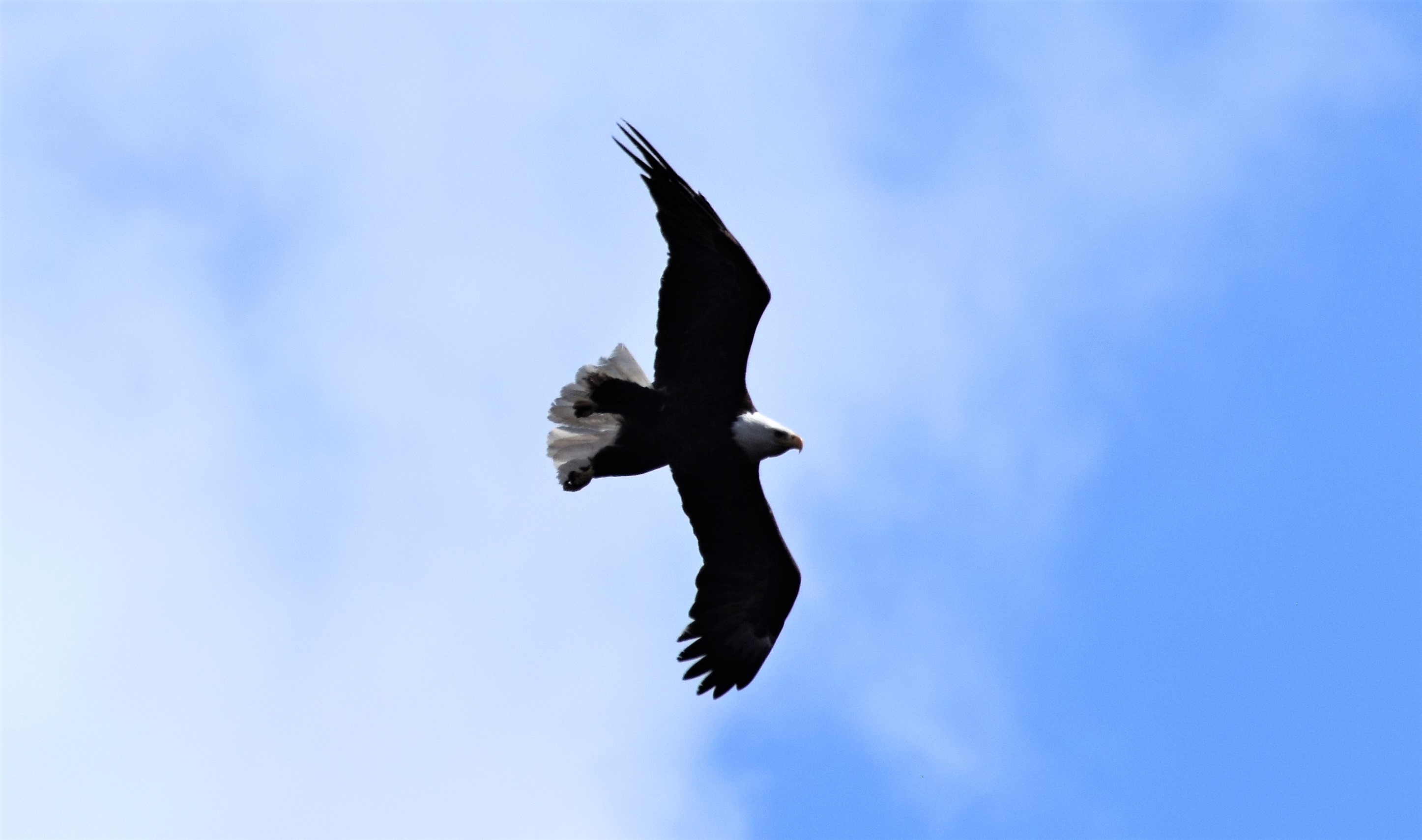


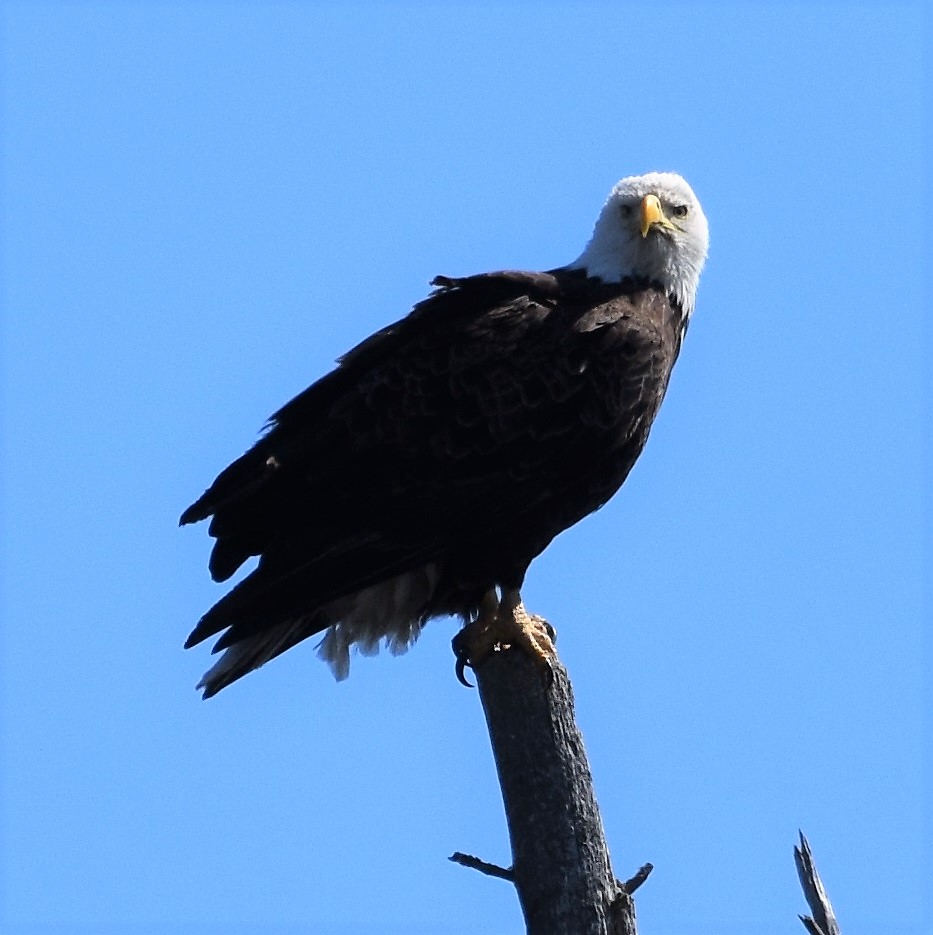


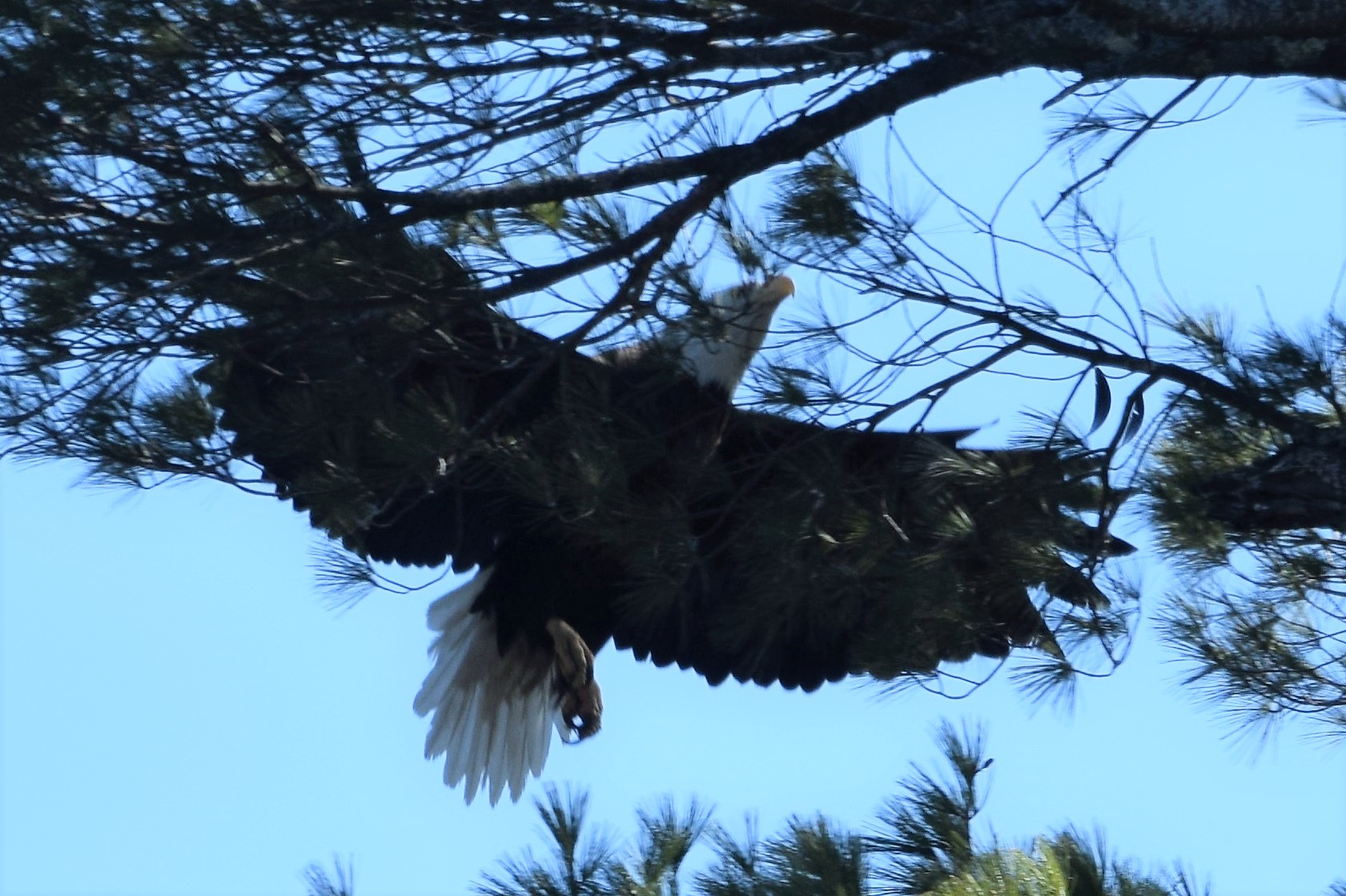

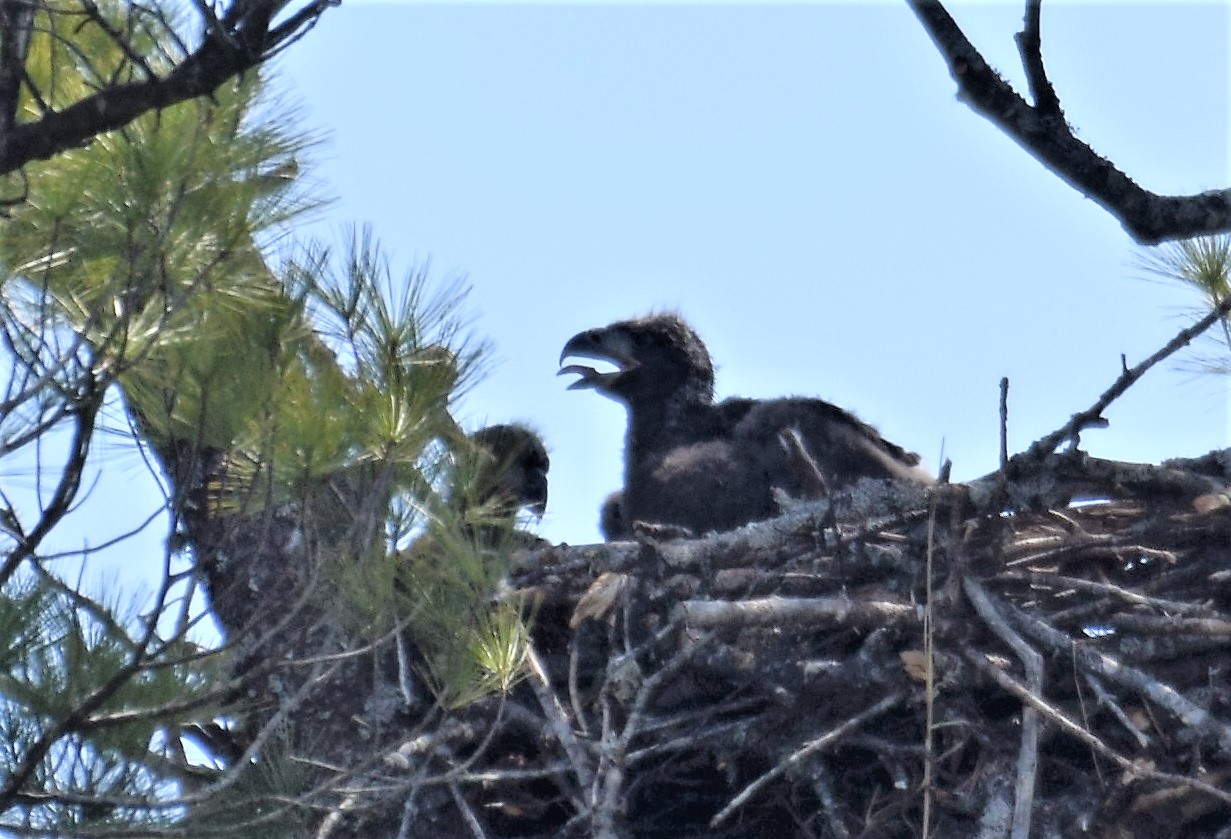
Adirondack Bald Eagles, Male approaches and joins Female in Nest, eaglets, April-May 2020, by Steve Hall, click to enlarge.
Emily Hall & Bharath canoeing below Bald Eagle, on Hegman Lake, Ely Minnesota, Sept. 2011, by Steve Hall
- "What is the use of a house if you haven't got a tolerable planet to put it on?"
- Henry David Thoreau
Great Eagle information site!
Sylvia, a Non-releasable Juvenile Bald Eagle at West Sound Wildlife Rehab, Bainbridge Island, Washington
Juvies develop the white head and tail between 4 and 5 years of age.
Photos by Wendy Hall
Here is Sylvia the day of her arrival at Adirondack Wildligfe Refuge, October 5th, 2011. Sylvia and her two male siblings were blown out of a nest during a bad storm on Bainbridge Island in the Spring of 2009. The brothers have since been rehabbed and released, but Sylvia injured her wing in a way, which will prevent her from ever flying, and she will be an exhibition bird at the Refuge. by Steve Hall
|
Ben Franklin on the Bald
Eagle as our National Symbol
Ben Franklin, the statesman, philosopher, naturalist, inventor and
all around Renaissance Man, was not all that thrilled with the choice of
the Bald Eagle as our national symbol, and seemed to prefer the wild turkey
as a utilitarian symbol, which is uniquely American, and often spelled the
difference between our wilderness forefathers eating or starving. In a letter
to his daughter, Franklin said, in part..... "For my own part I wish the Bald Eagle had not been chosen the Representative of our Country. He is a Bird of bad moral Character. He does not get his Living honestly. You may have seen him perched on some dead Tree near the River, where, too lazy to fish for himself, he watches the Labour of the Fishing Hawk; and when that diligent Bird has at length taken a Fish, and is bearing it to his Nest for the Support of his Mate and young Ones, the Bald Eagle pursues him and takes it from him. "With all this Injustice, he is never in good Case but like those among Men who live by Sharping & Robbing he is generally poor and often very lousy. Besides he is a rank Coward: The little King Bird not bigger than a Sparrow attacks him boldly and drives him out of the District. He is therefore by no means a proper Emblem for the brave and honest Cincinnati of America who have driven all the King birds from our Country . . . "I am on this account not displeased that the Figure is not known
as a Bald Eagle, but looks more like a Turkey. For the Truth the Turkey
is in Comparison a much more respectable Bird, and withal a true original
Native of America . . . He is besides, though a little vain & silly,
a Bird of Courage, and would not hesitate to attack a Grenadier of the British
Guards who should presume to invade his Farm Yard with a red Coat on." Of course, these days we often call politicians "turkeys", but I
believe we have a different meaning in mind. So....was Ben correct? Well, yes and no. Bald eagles are opportunistic predators, and we have seen them steal fish from our local ospreys, but that is fairly standard behaviour for predators. Grizzlys will try to steal kills from wolves, but if there are more than two wolves, they will tease and harass the grizzly, until it gives up and leaves. Ravens will lead wolves to a winter killed-moose, but when the wolves are finished gorging, and are just lying around, the ravens will cover the carcass, but instead of eating, will cleverly steal and cache chunks of meat, hiding the cache from the wolves and other ravens, to assure a larger take, than if they simply stayed at the carcass and ate. Lions occasionally lose a kill to hyenas, so the rule seems to be, if you can accomplish it without too much risk, sometimes by sheer force of numbers or overwhelming size or strength disparity, it's often easier to steal someone else's prey than to secure your own, particularly when prey is scarce, and your stomach is complaining. Steve
Hall
|
Immature Bald Eagle visiting the Refuge in Nov. 2011, by Steve Hall. More photos on Facebook
Wendy works with eagle injured by leghold trap in the Adirondacks
Photo, left, by NY State Dept. of Environmental Conservation, Photo on right by Trish Marki
Wendy works with Mike Pratt, director of West Sound Wildlife Rehab, Bainbridge Island, Washington
Wendy with "Liberty" at the World Bird Sanctuary in Missouri, photo by Jeff Meshach of WBS.
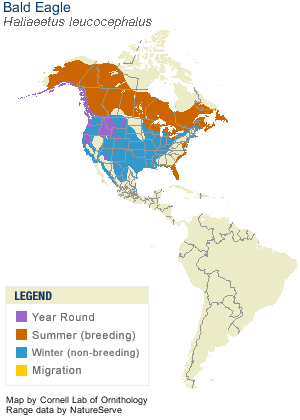

"Every scientific truth goes through three states: first, people say it conflicts with the Bible;
next, they say it has been discovered before; lastly, they say they always believed it."
Louis Agassiz

"The Philosophers Camp in the Adirondacks", 1858, by William James Stillman
Emerson is the figure in the middle between two trees
"Creativity is not the finding of a thing, but the making something out of it after it is found."
James Russell Lowell

"The Bird Man"
Pastel by Wendy
| Home |
Release of Rehabbed
Animals |
Learn
About Adirondack & Ambassador Wildlife |
Critter
Cams & Favorite Videos |
History
of Cree & the Adirondack Wildlife Refuge |
| The Adirondacs Ralph Waldo Emerson A JOURNAL DEDICATED TO MY FELLOW TRAVELLERS IN AUGUST, 1858 Wise and polite,--and if I drew We crossed Champlain to Keeseville with our friends, Next morn, we swept with oars the Saranac, Northward the length of Follansbee we rowed, The wood was sovran with centennial trees,-- 'Welcome!' the wood-god murmured through the leaves,-- Ten scholars, wonted to lie warm and soft In Adirondac lakes Look to yourselves, ye polished gentlemen! Ask you, how went the hours? Our heroes tried their rifles at a mark, Two Doctors in the camp Lords of this realm, Hard fare, hard bed and comic misery,-- Our foaming ale we drank from hunters' pans, Nor doubt but visitings of graver thought And presently the sky is changed; O world! With a vermilion pencil mark the day A spasm throbbing through the pedestals We flee away from cities, but we bring The holidays were fruitful, but must end; |
|
Artists Home |
ADK Vacation Rentals |
ADK Real Estate |
|||||||||||